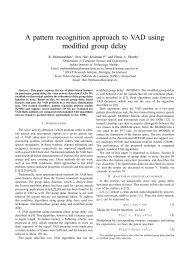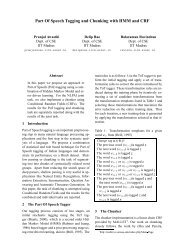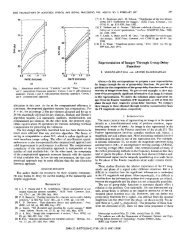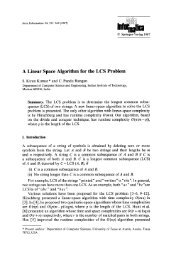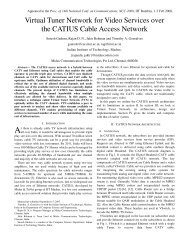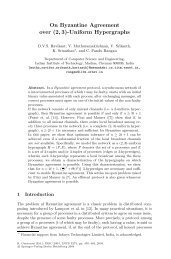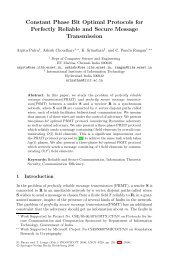TRANS: Schema-Aware Mapping of OWL Ontologies into Relational ...
TRANS: Schema-Aware Mapping of OWL Ontologies into Relational ...
TRANS: Schema-Aware Mapping of OWL Ontologies into Relational ...
Create successful ePaper yourself
Turn your PDF publications into a flip-book with our unique Google optimized e-Paper software.
3. DDOProp_Table1: It stands for Disjoint Directed<br />
acyclic object property graph table1. It stores<br />
property instances <strong>of</strong> object property Pr<strong>of</strong>TrainingFrom.<br />
4. DDDProp_Table1: It stands for Disjoint Directed<br />
acyclic datatype property graph table1. It stores<br />
property instances <strong>of</strong> datatype property <strong>of</strong>ficeNumber.<br />
5. PropDomain: It stands for domain <strong>of</strong> properties.<br />
It stores domain information <strong>of</strong> Pr<strong>of</strong>TraningFrom<br />
property.<br />
6. PropRange: It stands for range <strong>of</strong> properties.<br />
It stores range information <strong>of</strong> Pr<strong>of</strong>TrainingFrom<br />
property.<br />
7. store_level: It stores the transitive chains and<br />
levels <strong>of</strong> the university ontology class hierarchy.<br />
8. store_plevel: It stores the transitive chains and<br />
levels <strong>of</strong> the university ontology object property<br />
hierarchy.<br />
9. store_dplevel: It stores the transitive chains<br />
and levels <strong>of</strong> the university ontology data property<br />
hierarchy.<br />
4 Experimental Setup<br />
Following is experimental setup.<br />
Processor: 2.6 GHz Intel Celeron Processor<br />
RAM: 1 GByte RAM<br />
Hard disk: 80 GByte<br />
Operating System: Fedora Core 3<br />
Database: PostgreSQL 8.1<br />
JDBC Driver: JDBC driver 3<br />
Java: Sun JDK 1.5.0<br />
<strong>TRANS</strong> is compared with Genea schema aware<br />
mapping tool as Genea performs better than the<br />
other available schema aware mapping tools in the<br />
literature. Both <strong>TRANS</strong> and Genea tool are experimented<br />
on the above experimental setup. We use<br />
the data generator tool UBA version 1.7[16] with<br />
seed value 0 to generate LUBM University ontology<br />
random individual data. For comparing <strong>TRANS</strong> with<br />
Genea we have built eleven LUBM test sets (LUBM 1,<br />
LUBM 3, LUBM 5, LUBM 7, LUBM 10, LUBM 15,<br />
LUBM 20, LUBM 25, LUBM 30, LUBM 40, LUBM<br />
50) that correspond to size <strong>of</strong> 10 to 500 MBytes.<br />
Genea Genea was implemented in MySQL[19]<br />
database and <strong>TRANS</strong> is implemented in<br />
PostgreSQL[20]. So to have a fair comparison,<br />
we obtained Genea source code from Genea author<br />
and customized some part <strong>of</strong> it to make it work<br />
with PostgreSQL. We use the SQL script <strong>of</strong> Genea<br />
Query no. Input Selectivity Description from LUBM Benchmark and Genea paper<br />
1 large high Queries about just one class and one property and<br />
does not assume any hierarchy information or inference.<br />
3 large high Similar to Query 1 but class Publication has a wide<br />
hierarchy.<br />
4 small high It assumes subClassOf relationship between Pr<strong>of</strong>essor<br />
and its subclasses. Class Pr<strong>of</strong>essor has a wide<br />
hierarchy. Another feature is that it queries about<br />
multiple properties <strong>of</strong> a single class.<br />
6 large low This query queries about only one class. But it assumes<br />
both the explicit subClassOf relationship between<br />
UndergraduateStudent and Student and implicit<br />
one between GraduateStudent and Student.<br />
7 large high This query is similar to Query 6 in terms <strong>of</strong> class<br />
Student but it increases in the number <strong>of</strong> classes and<br />
properties.<br />
11 small low to high depending on the used dataset Inference about the subOrgnizationOf relationship<br />
between instances <strong>of</strong> ResearchGroup and University<br />
is required to answer this query.<br />
14 large low This query is the simplest in the test set, as it relies<br />
only on one triple.<br />
Table 1: Selected LUBM queries for <strong>TRANS</strong> and Genea<br />
specified in their source code for ontology schema<br />
creation. Genea is also experimented on the above<br />
experimental setup.<br />
<strong>TRANS</strong> <strong>TRANS</strong> uses Pellet[10, 12] reasoner for computing<br />
ontology hierarchy and Jena[17] reasoner for<br />
ontology data loading as Jena is not able to return<br />
some <strong>of</strong> the asserted conceptual data. Query response<br />
time is calculated based on Genea specified<br />
SQL queries for LUBM test queries.In <strong>TRANS</strong>, for<br />
having a more fair comparison query response time is<br />
calculated without the cache effect. For flushing the<br />
cache effect, we restarted our system before every new<br />
LUBM[3] test query reading for both <strong>TRANS</strong> and Genea.<br />
Table 1 lists the set <strong>of</strong> selected LUBM test queries<br />
for both <strong>TRANS</strong> and Genea. In table 1, Query no.<br />
column specifies the selected LUBM query number,<br />
Input column specifies the size <strong>of</strong> ontology input data<br />
for a query, Selectivity column depicts the estimated<br />
proportion <strong>of</strong> the class instances involved in the query<br />
that satisfy the query criteria and Description column<br />
specifies about the nature <strong>of</strong> each queries. Following<br />
are the reasons for query selection. We got Genea SQL<br />
queries and code from Genea author. Genea experimented<br />
on the set <strong>of</strong> queries in table 1 so to have<br />
a fair comparison <strong>TRANS</strong> also tested on the same<br />
set <strong>of</strong> LUBM test queries. Another reason is <strong>TRANS</strong><br />
currently does not directly support SPARQL[23] and<br />
RQL[8] ontology languages. LUBM test queries in<br />
SPARQL are mapped to corresponding SQL queries.<br />
Queries in table 1 operates directly on database and<br />
easy to be converted <strong>into</strong> SQL for fair comparison.<br />
5 Query and <strong>Schema</strong> Complexity<br />
Comparison<br />
Query complexity comparison is done on the basis <strong>of</strong><br />
number <strong>of</strong> select, join and union clauses used in the



